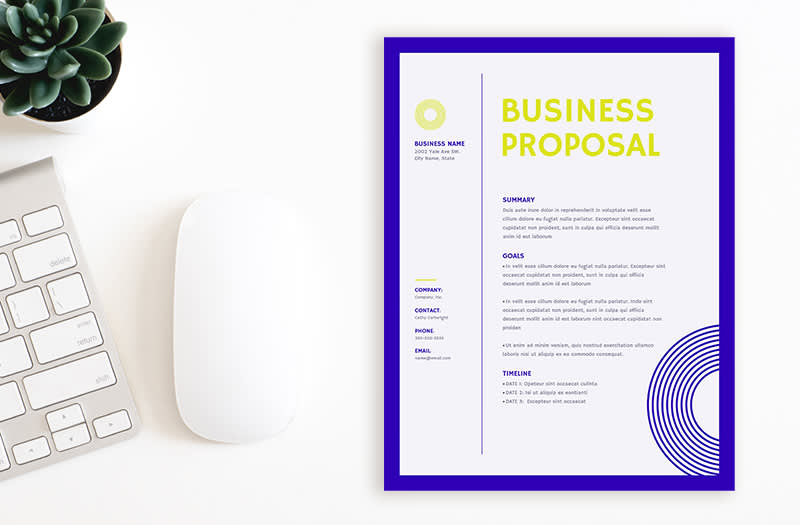
Let’s talk business proposals. While they obviously help you “propose business,” there are critical strategies to do so effectively. Business proposals are the most elaborate and comprehensive documents used by B2B or business-facing companies to pitch your mission to sponsors, clients, or C-level execs. A timid proposal could cost you clients, so let’s get to work.
In this tutorial, we’ll include
Why business proposals matter
Types of business proposals
What to include in a business proposal
Effective strategies to land your projects
Diverse business proposal ideas to sculpt on your own
Encouragement along the way (you got this!)
Why business proposals matter

Think you can seal the deal with this design? Make it your own in PicMonkey!
Business proposals are critical for expanding clientele, landing projects, increasing outreach, networking, and solving customer problems. Just as people use resumés to pitch themselves, business people use business proposals to pitch…their business.
When most people hear business proposals, they go straight for the details – how much will the project cost, when can it get done, yada yada yada. While those details do matter, let it be known that how business proposals look is equally important.
Presentation is everything – not just how you present the information – but how the information presents. To prep for your prez, take advantage of PicMonkey's multi-page templates for airtight visual cohesion.
Throughout your proposal, be sure to include the following:
Use colors that cater to your business, cater to your client, or both
Use compelling and confident language
Support your message with inspiring stock photos or your business logo
Find a balance between your design elements
Put yourself in your customer’s shoes. If you were them, how would you best receive information? What would you need to see, hear, and feel in order to seal the deal? A single-spaced 80-page contract isn’t digestible or enticing. While old paradigms deem business cut-throat and/or cut-and-dry, true innovation, transformation, and effective change in the workplace require creativity.
Sure, business proposals are serious, but the way you navigate them should be intuitive. Which colors evoke the mood you’re going for? Check in with yourself each step of the way and proceed accordingly.
Types of business proposals

Think you can seal the deal with this design? Make it your own in PicMonkey!
Business proposals can vary depending on the project and the proposal type. There are three types of proposals:
Formally solicited proposals
Informally solicited proposals
Unsolicited proposals
Let’s break ‘em down.
Formally solicited
This form of business proposal comes from buyers who request one from you. In this case, you’ll know the project demands and will be asked to provide a proposal to see if you match the buyer’s needs.
Informally solicited proposals
These business proposals still come from buyers who request proposals from you, but you don’t yet know the project demands. Informally solicited proposals usually come from referrals or informal conversations, so you’ll have to make one with limited info.
Unsolicited proposals
Unsolicited business proposals are comparable to cold-pitch emails. In this case, you won’t have direct contact with the buyer (yet), so you’ll create a proposal from your own due diligence and research in order to gain contacts.
Once you know which proposal to create, you’ll want to include the following:
Title Page
Table of Contents
Executive Summary
Perceived problem
Proposed solution
Why you qualify
Timeline
Cost
Terms and conditions
Conclusion / request for acceptance
While these requirements seem straightforward, know that business proposals can land anywhere from 30-50 pages. No need to panic – really. Consider this length an opportunity to say everything you need to make yourself a worthy candidate.
Many businesses literally depend on the success of their business proposals, so now’s not the time to skimp.
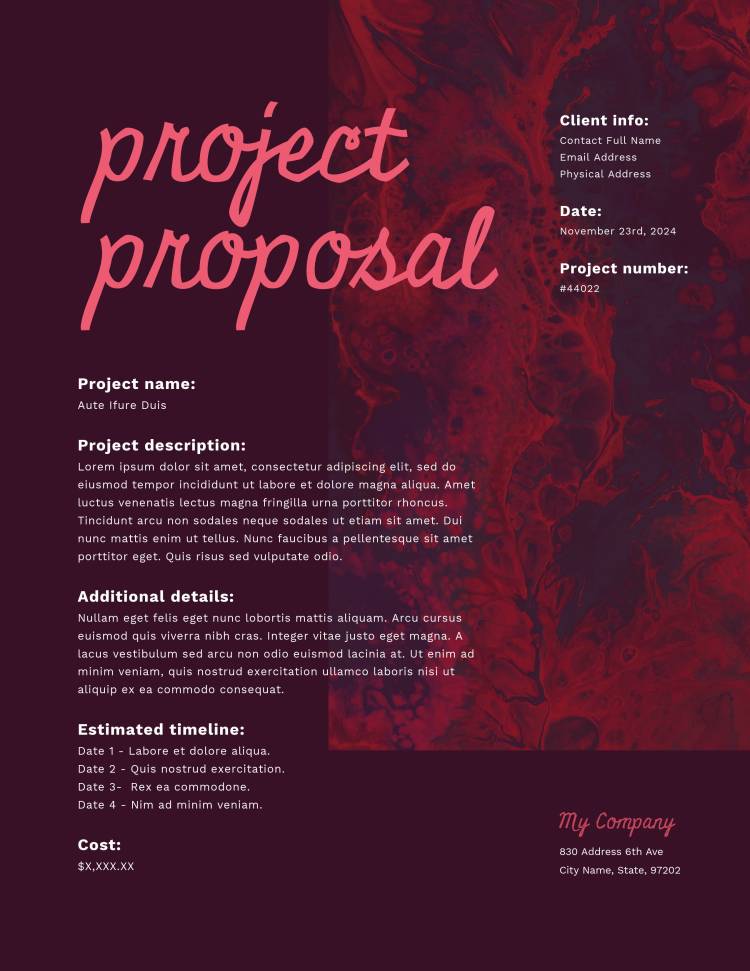
Think you can seal the deal with this design? Make it your own in PicMonkey!
Pro Tip: Use PicMonkey’s customizable templates to your advantage. Dig a certain style? Duplicate the page and switch up the background color to keep it consistent – or – use a different template to separate each section! Plus, our templates guarantee time efficiency. Why start from scratch when you’ve got detailed, professional, and easy-to-use designs at your service? (We truly love making things easy for you.)
Top tips for business proposal content
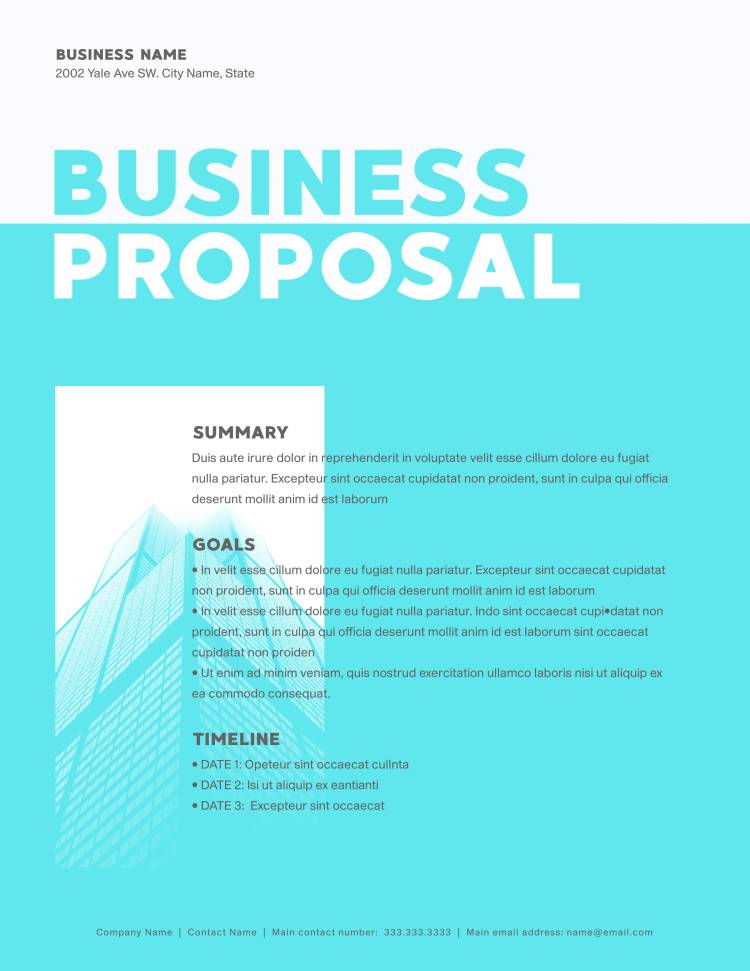
Think you can seal the deal with this design? Make it your own in PicMonkey!
Title page and table of contents
The above template models a solid cover page. It serves as the customer’s “teaser.” Let them know who you are, what you’ll be covering, and what to expect. By doing so, this page segues seamlessly into the table of contents.
If you can, find natural ways to thread your business’s name, location, and contact throughout the proposal. The title page is the first and most expected place to do so. Making your info accessible reminds clients who you are and contributes to a lasting impression. The less your customer has to work to understand who you are – especially if it’s an unsolicited proposal – the better.
And, know that the “devil is in the details” only if you forget the details! For example, the above template suggests a project for architecture, construction, or design. Heck, maybe it’s a pic of the seller’s building. Regardless, choose your symbols wisely. Suggesting architecture to a corporate tech company probs won’t fly (neither will abbrevs like these).
Pro Tip: Just like authors, it’s okay to leave the table of contents until the end. Some people know where their proposal’s going, but others prefer to fill in the blanks once they’ve completed it.
Executive summary
Once you crush your title page and table of contents, it’s time to hash out the executive summary. If you were writing a psychology paper, this would be called the abstract.
Summarize the talking points, your objective, the intention of the proposal, and the intended outcomes. Ease your customer into your proposal with a thorough explanation of who you are, how you came to find them, and why you think you can help.
Problem statement and proposed solution
Sensibly, the problem statement and proposed solution come after introducing yourself and the project. Clearly identify what the problem is, why it’s a problem, why it matters that it’s a problem, and how you can solve it.
It’s best to treat your proposal like a cohesive narrative. Take books, for example. Every book has a copyright page, acknowledgements, table of contents, preface, and an intro all before starting chapter one. The same is true here; consider how to thread each section into the next to leave clients with minimal questions.
Pro Tip: Play devil’s advocate with yourself as you craft your problem statement and solution. How might your customer object? How can you answer any questions they might have before they ask them? Stay one step ahead by covering all your bases.
Qualifications
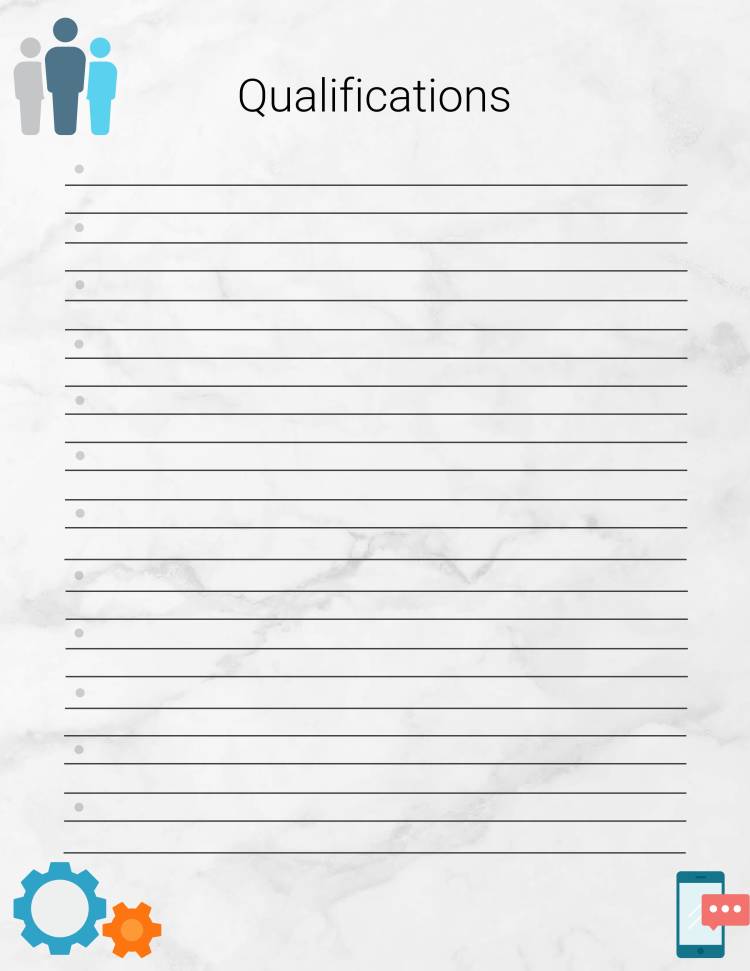
Think you can seal the deal with this design? Make it your own in PicMonkey!
When it comes to mapping out your qualifications, more is better. Like a resumé, include the titles of data-driven achievements and when they were granted. In the event you need to describe them, be sure to leave enough room to do so.
Pro Tip: Decide how to order your qualifications. Resumés list the most recent form of employment first and work backwards. Here, consider putting your proudest and biggest accomplishments at the top. Make your customers realize you’re not only the best – but the only person for the project.
Project logistics
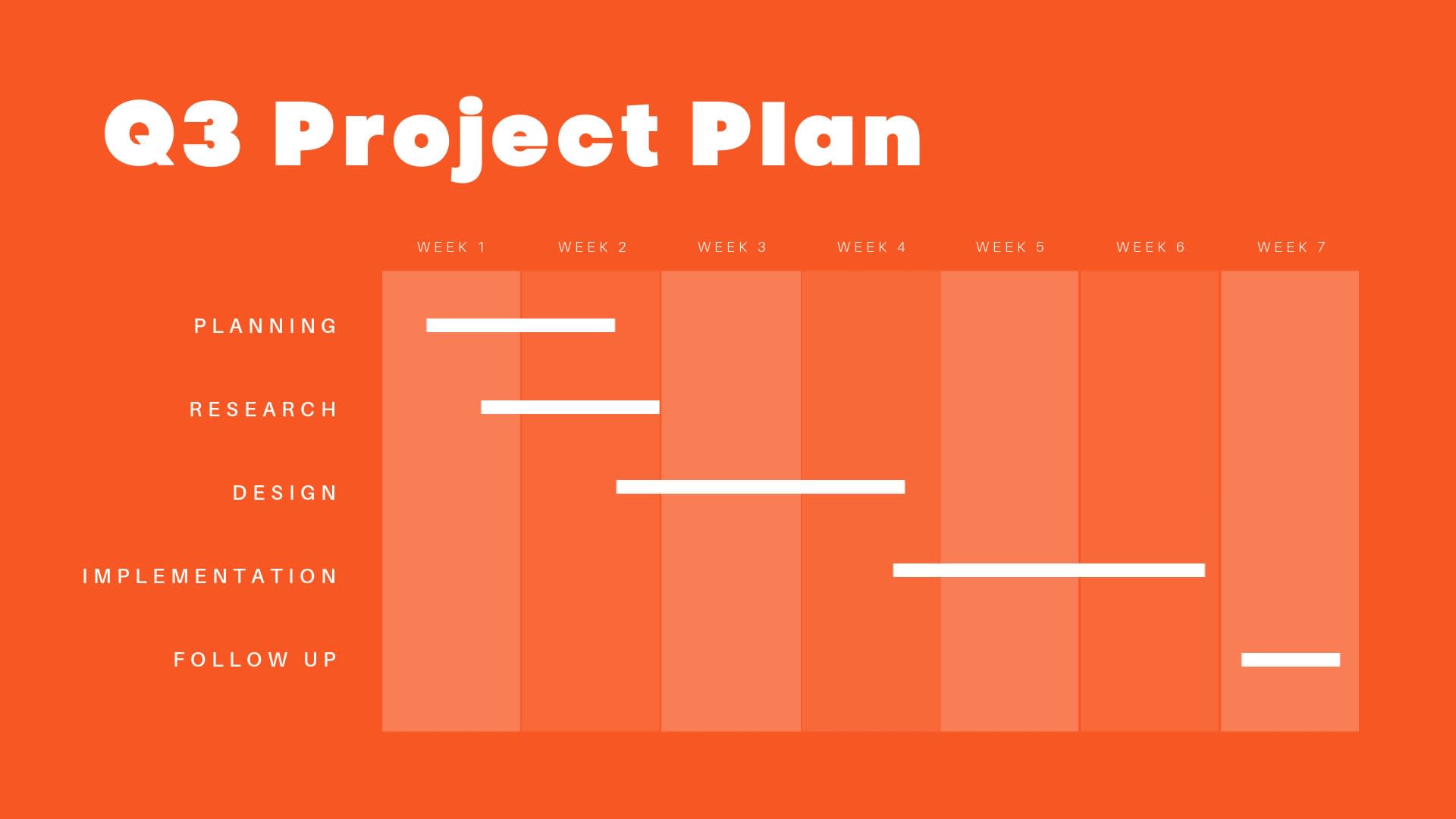
Think you can seal the deal with this design? Make it your own in PicMonkey!
Once you’re ready to talk project logistics, use templates that set you up for success. Timelines are perfect for illustrating milestones, deadlines, and expectations. Be transparent about the project’s needs so as to not underestimate (or overestimate) the time and energy required for it.
Timelines create an algorithm that helps customers understand project costs and predicted time-tables, so it’s up to you to communicate clearly what is needed.
Pro Tip: If you need more space to explain what each stage of planning, research, or design entails, take it. Don’t edit the details for the sake of aesthetics; use templates that give you the freedom to leave it all on the table. Conversely, every customer knows what overselling looks like, so remember to edit, too. Go for that Goldilocks balance.
Proposal conclusion
Once you establish the cost and its associated terms and conditions, you’ll be nearing the end of your business proposal (woohoo!). Summarize everything you’ve discussed and re-emphasize why your business is the best business for the job.
Leave space for signatures to make it official, and include necessary follow-up contact info. Once that customer’s pen is in hand, you, my friend, are in BUSINESS.
Like anything else, the creation process requires building, writing, and editing – multiple times over. Find your flow as you write your business proposal and know that it doesn’t have to be written in order. Maybe one day you lay out your templates. Maybe another you bust out the content. Maybe you work back-to-front. It will all get done one way or another. Make a list of things you need to get done, if it'll help.
Take breaks, scream positive affirmations to yourself when stressed, smile in the mirror, get some primo snacks, celebrate each completed section, and go win over some clients. We’re amped, you’re amped, everyone’s amped about your best business proposal yet!
Our PicMonkey blog is a treasure box full of resources for your business. Learn how to make impactful flyers, get inspiration for your next infographic design, create conversion-centric social ads, and so much more!
